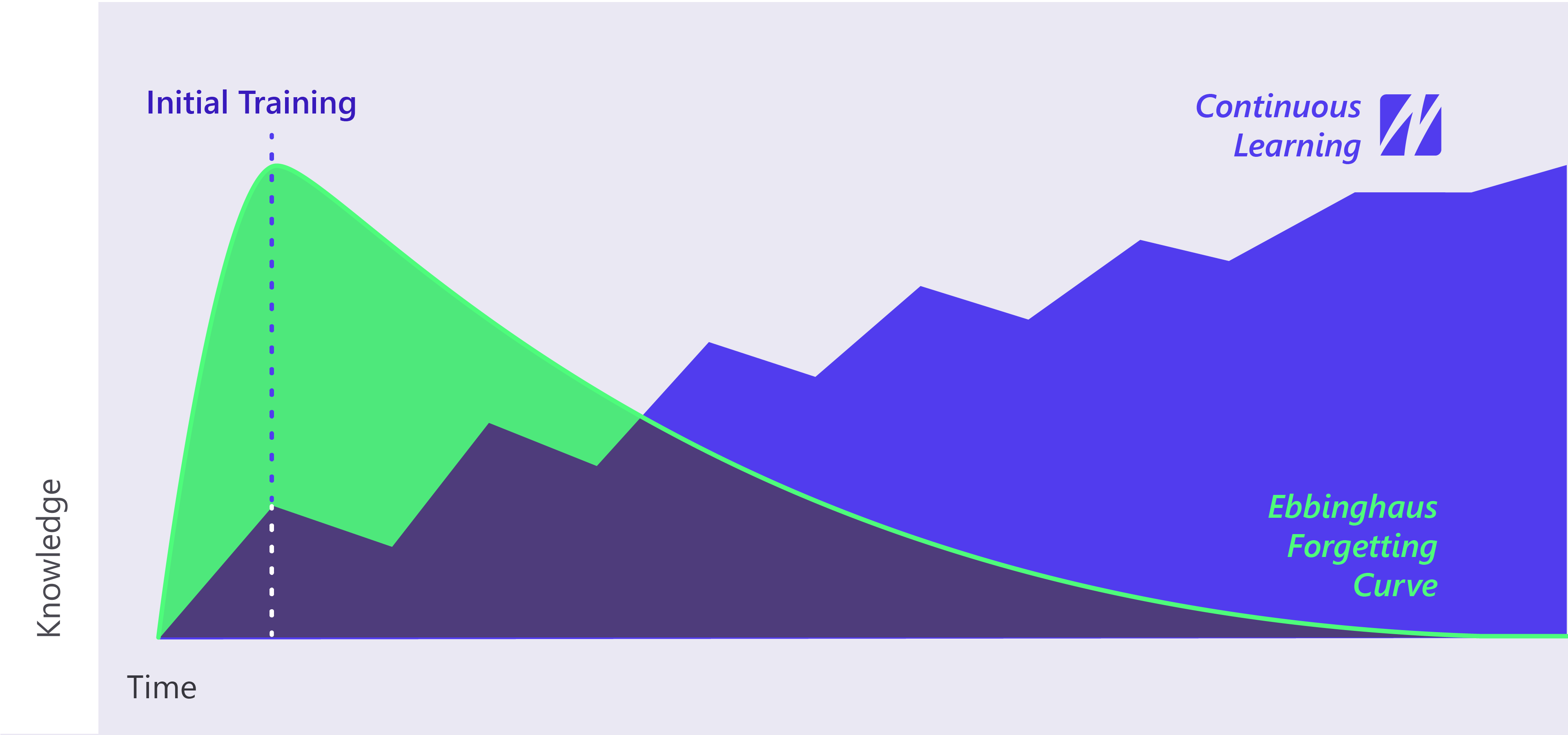Why Repetition is Essential for Effective Communication
Estimated reading time: 6 minutes
In our previous blog, we gave you six important reasons to choose for an all-in-one solution for your internal communication. One of those six reasons was the power of repetition: a multitude of various communication channels within one organization namely ensures that your employees repeatedly see the same message through different channels. This power of repetition is crucial for several reasons if you want your employees not only to receive information but also to remember and apply it. In this blog, we explain why repetition is crucial to effective communication.
Table of contents
Your Brain Reacts to Repetition
We’re worse at remembering information than we often might think. In fact, we forget no less than ninety percent of what we learn within thirty days! At least, when it comes to new information. However, when (new) information is presented to us repeatedly, the brain reacts differently. At the end of the nineteenth century, German psychologist Hermann Ebbinghaus called this effect the ‘Forgetting Curve’. The Forgetting Curve describes how new knowledge fades over time. However, this downward trend can be broken by repeating information over and over. By repeating information, there’s a better chance of understanding and internalizing it.

Therefore, repetition plays an important part in communication. For example, an advertisement must be shown three to twenty times on average before a consumer considers buying, or actually buys a product. Only after an exposure of three to twenty times, the message will linger. The Forgetting Curve can also be applied to internal communication. Employees see, hear, and understand your messages better, once they are repeated a few times.
Training Becomes More Efficient
We wrote a blog about it before, but we can’t repeat it often enough: repetition makes training more effective. It doesn’t matter who you train or which training someone follows; if an employee receives core messages of a training only once, the chances they won’t remember what they learned are much higher. After all, we forget ninety percent of what we learn within thirty days. Applying this new knowledge will then be more difficult. Continuously showing small chunks of a training (in other words: repetition) ensures that a message will integrate much better. Additionally, employees can genuinely apply what they have learned.
Remembering and being able to apply new information, whether through a training or not, is crucial in many industries: in the healthcare industry, for example, healthcare personnel’s awareness of the latest safety rules can literally save patients’ lives. In the industrial sector, the application of important training can be important for the safety of workers – the correct implementation of certain new procedures can increase physical safety. Another great example is the repetition of the FAFS course. Commonly, this course and knowledge is only refreshed once a year, which actually isn’t often enough. But raising awareness to other, non-physical risks like cyber risks such as phishing is important, too. Cybersecurity awareness may not directly save lives, but it can save your company or organization a lot of misery.
Repetition provides clarity
A message that’s only delivered once or twice doesn’t always reach its goal; without repetition, we forget ninety percent of what we learn within thirty days. And given the enormous amount of information that employees must process daily, it’s conceivable that a message that’s brought only once, will probably get lost in the information overload. However, if a message is brought to someone’s attention more often, it’s easier to process the information. This way, they’re more likely to understand the message and to be able to incorporate it into their working practices. The contents and goal of the information will then be clearer, which has its advantages, too.
Employees who understand important information will feel well-informed. And well-informed employees are often more engaged in their organization. Among other advantages, well-informed and committed employees cause higher levels of success and productivity; they will want to achieve what’s best for their organization. For both employer and employee, there are nothing but benefits.
Cross-device: making repetition even more powerful
Those who want to take repetition to the next level, should implement a cross-device strategy. Making your message available through multiple devices is essential to reach everyone in your organization. Different generations prefer different means of communication, but some employees also have more limited or even no access to certain channels of communication due to the nature of their work. A driver or factory worker, for example, can’t always be reached through email or Microsoft Teams.
However, when information is displayed on digital signage screens or available in a mobile app, employees can view it whenever it suits them. Even when they’re at home or on the road, they can view the information effortlessly. An all-in-one communication platform doesn’t only allow you to easily repeat your message, it also ensures that no one is left out. You can reach everyone in your organization, regardless of function, team or location.

We forget ninety percent of what we learn within thirty days – but you won’t forget that anymore after we’ve repeated it four times! Do you want to know more about the benefits of the power of repetition? Download or free infographic The power of repetition or contact us, we’re happy to discuss how the power of repetition can help your organization.

How do I measure whether repetition is improving communication outcomes?
With Netpresenter, you can track metrics such as message views, read confirmations, employee surveys, and behavioral change indicators (e.g., policy compliance, training completion rates). These insights help you fine-tune the frequency and format of repeated messages to maximize effectiveness.
How can Netpresenter help with message repetition without overwhelming employees?
Netpresenter distributes messages across multiple touchpoints—such as screensavers, digital signage, mobile devices, and desktops—allowing you to subtly and consistently repeat messages without spamming one single channel. You can schedule recurring messages, vary the formats, and target specific audiences for relevance and impact.
Which types of messages benefit most from repetition?
Repetition is particularly valuable for:
Safety instructions and compliance policies,
Company mission and core values,
IT security protocols,
Crisis procedures,
Ongoing campaigns (e.g., health & wellbeing),
Training reinforcement.
These messages often require behavior change or long-term recall, which repetition helps supp
How often should I repeat internal messages without annoying my employees?
The right frequency depends on the type of message. Critical or strategic messages (e.g., safety rules, policy changes, core values) can be repeated multiple times per week in varied formats. The key is to use different channels (e.g., digital signage, mobile alerts, screensavers) and keep the presentation engaging to avoid fatigue.
Why is repetition so important in internal communication?
Repetition reinforces memory and comprehension. Employees are bombarded with information daily, so repeating key messages helps ensure they are absorbed and retained. Just like in advertising or learning, repeated exposure makes messages more familiar and more likely to prompt action.

